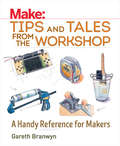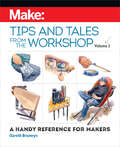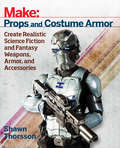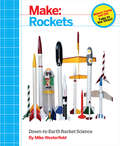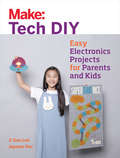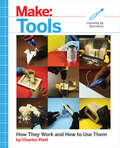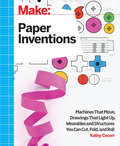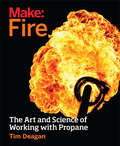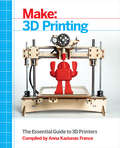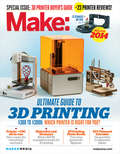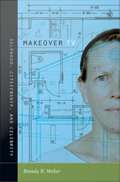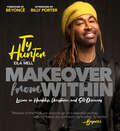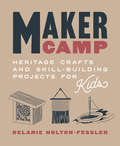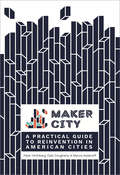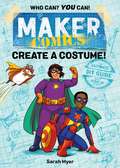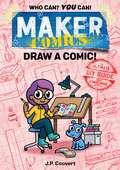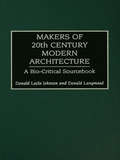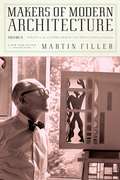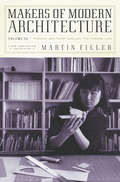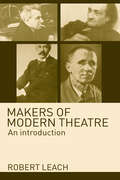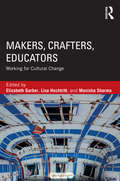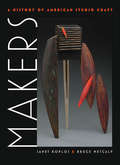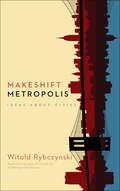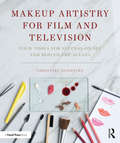- Table View
- List View
Make: A Handy Reference for Makers
by Gareth BranwynThe hard-earned tips and tricks gained by experience are the hidden currency of makers -- passed along in workshops and makerspaces by example and by retelling -- shared wisdom that will help you work smarter, easier, and more efficiently. Who doesn't remember with gratitude the insider secrets they learned from from a parent, shop teacher, or artisan? The best ones are never forgotten!This benchtop reference collects hundreds of ingenious and indispensable shop tips and pearls of wisdom collected by the editors of Make: and some of the most talented and prolific makers who've contributed to the magazine and Maker Faire over the past decade.Inside you'll find tips for measuring and cutting, gluing and fastening, clamping and joining, drilling, shop organizing, maintenance and repair, and more. The topics covered run the gamut from traditional shopcraft to electronics and soldering. You'll also encounter fascinating tales from experienced makers whose personal stories illuminate their favorite tools and best discoveries. Illustrated in full color with photos, drawings, and comic strips, Tips and Tales from the Workshop will entertain and enlighten while inspiring you.Get ready to smack your head and ask yourself, "Why didn't I think of that?"Praise for Tips and Tales from the Workshop:"Gareth Branwyn is the Tip Master. He scours the workshops of the world for practical, time-saving, life-altering tips to help you make stuff better, faster, and cheaper. This book rounds up the best ones he knows." --KEVIN KELLY, creator of Cool Tools and Wired Senior Maverick"Gareth has essentially created a magic book for makers." --DONALD BELL, Maker Project Labs"Tips and Tales from the Workshop is sure to inspire anyone to get making with newfound ease and satisfaction. This book embodies the spirit of great mentors, across every medium, and imparts a wizard-like cleverness to its readers. I thought I was clever, and this book has already prevented at least a dozen new mistakes in my studio. It's "ah-ha" moment overload!" --BECKY STERN, DIY guru and Instructables content creator"It must be hard to write a book like this with such uncommon clarity and in so entertaining a fashion as Gareth Branwyn has done here. Gareth clearly has a deep understanding of making and those who make because he is a maker himself. Tips and Tales from the Workshop is jam packed with invaluable information; it is both a fun read and a reliable shop reference for any do-it-yourselfer." --ANDY BIRKEY, YouTube maker
Make: A Handy Reference for Makers
by Gareth BranwynThis ALL NEW benchtop reference presents more ingenious and indispensable shop tips and pearls of wisdom collected by the editors of Make: and some of the most talented and prolific makers who've contributed to the magazine and Maker Faire over the past decade. Inside you'll find ALL NEW tips for measuring and cutting, gluing and fastening, clamping and joining, drilling, shop organizing, maintenance and repair, and more. The topics covered run the gamut from traditional shopcraft to electronics and soldering. You'll also encounter even more fascinating tales from experienced makers whose personal stories illuminate their favorite tools and best discoveries. Illustrated in full color with photos, drawings, and comic strips, Tips and Tales from the Workshop Volume 2 will continue to entertain and enlighten while inspiring you.
Make: Create Realistic Science Fiction & Fantasy Weapons, Armor, and Accessories
by Shawn ThorssonHave you been trying to think of a way to conquer your local comic convention through cosplay? Do you gaze with envious eyes upon the fan-made suits of armored awesomeness strolling around every year on Halloween? Do you have a spot on your wall, bookshelf, or desk that desperately needs to be filled with a screen-accurate replica of your favorite science-fiction or fantasy weapon? If so, look no further. We've got just the book for you!In this book, master prop maker Shawn Thorsson uses his unique blend of humor and insight to turn years of painful experience into detailed explanations. He'll show you many of the tools, methods, and processes that you can use to create professional-looking science fiction and fantasy props and armor. The ultimate collision of creative imagination and practical maker skills, making props and costume armor involves sculpting, molding, casting, 3D printing, CNC fabrication, painting, and countless other techniques and technologies.In this book, you'll learn:Basic fabrication methods using inexpensive, commonly-available tools and materialsSimple, low-cost methods to make foam armor out of easy-to-find foam matsHow to use the popular Pepakura software to build 3D models with paperMultiple molding and casting techniquesHow to build a "vacuforming" machine to make armor from plastic sheet stockPainting and weathering techniques that will bring your props to lifeJust enough safety advice to keep you from losing body parts along the wayWhether you're just a beginner or a seasoned builder with countless projects behind you, this book is sure to be an invaluable addition to your workshop library.
Make: Down-to-Earth Rocket Science
by Mike WesterfieldThis book teaches the reader to build rockets--powered by compressed air, water, and solid propellant--with the maximum possible fun, safety, and educational experience.Make: Rockets is for all the science geeks who look at the moon and try to figure out where Neil Armstrong walked, watch in awe as rockets lift off, and want to fly their own model rockets. Starting with the basics of rocket propulsion, readers will start out making rockets made from stuff lying around the house, and then move on up to air-, water-, and solid propellant-powered rockets. Most of the rockets in the book can be built from parts in the Estes Designer Special kit.
Make: Easy Electronics Projects for Parents and Kids
by Jaymes Dec Ji Sun LeeKid Crafts introduces younger children to the magic of electronics through the softer side of circuits! Young explorers will learn about electronics through sewing and craft projects aimed at maker parents and their children, elementary school teachers, and kids' activity leaders. Each project introduces new skills and new components in a progressive series of projects that take learners from the very basics to understanding how to use components such as sensors, transistors, and timers. The book is breezy, highly illustrated, and fun for everyone!
Make: How They Work and How to Use Them
by Charles PlattWhether you’re interested in becoming a handyman or developing artisanal woodworking skills, the place to begin is by learning the fundamentals of using basic workshop tools correctly. The place to find out how is right here. Make: Tools is shop class in a book.Consumer-level 3D printers and CNC machines are opening up new possibilities for makers. But there will always be a need for traditional workshop skills and tools. Charles Platt's Make: Tools applies the same approach to its subject matter as his bestselling Make: Electronics -- in-depth explanations and hands-on projects that gradually increase in level of challenge.Illustrated in full color with hundreds of photographs and line drawings, the book serves as a perfect introduction to workshop tools and materials for young adults and adults alike. Platt focuses on basic hands tools and assumes no prior experience or knowledge on the part of the reader. The projects all result in fun games, toys, and puzzles. The book serves as both a hands-on tutorial a reference that will be returned to again and again.
Make: Machines that Move, Drawings that Light Up, and Wearables and Structures You Can Cut, Fold, and Roll
by Kathy CeceriPaper is incredible stuff. It's easy to cut, but incredibly strong. It's disposable, but can last for centuries. It can stand as stiff as a board, pop up like a spring, or float like a leaf. And its invention changed the world forever. Perfect for kids, parents, and educators, Paper Inventions is a project-based book with full color illustrations, step-by-step instructions, supply lists, and templates that allow you to follow along with the book or devise something entirely new. Each chapter features new projects that will challenge and intrigue everyone, from beginning to experienced Makers. In this book, you'll learn to make: A light-up paper cat that shows how switches and sensors workAn action origami robot wormEdible rice paper perfect for secret messagesA space rover that moves thanks to paper machineryA paper generator that creates electricity when you tap or rub it Heat-activated paper models that fold themselvesA geodesic dome big enough to crawl into--from newspaper!
Make: The Art and Science of Working with Propane
by Tim DeaganLearn how to safely build projects that burn, poof, "boosh," and flare! This complete reference and hands-on guide to working with propane explains how to create a variety of flame effects projects that can be built with common tools and materials.Starting from the basics, this book explains everything you need to know to safely work with propane. An essential reference for building projects like fire cannons, forge torches and flaming sculpture, Make: Fire explains the history, chemistry, and combustion of propane. Using that knowledge as a foundation, readers can then construct a variety of flame-based project on their own using illustrated, step-by-step instructions provided by the author. With simple tools, you can build a gorgeous flambeau, a torch capable of melting aluminum, or flame effects that ignite jaw-dropping fireballs in the sky. Focusing on safety at every step and written by a licensed Flame Effects Operator, this book provides information that has never been brought together in one place. With this guide, readers will master the fundamental components of almost all propane-based projects and develop the skills they need to create their own flame devices and artworks.
Make: The Essential Guide to 3D Printers
by Anna Kaziunas FranceThe 3D printing revolution is well upon us, with new machines appearing at an amazing rate. With the abundance of information and options out there, how are makers to choose the 3D printer that's right for them? MAKE is here to help, with our Ultimate Guide to 3D Printing. With articles about techniques, freely available CAD packages, and comparisons of printers that are on the market, this book makes it easy to understand this complex and constantly-shifting topic.Based on articles and projects from MAKE's print and online publications, this book arms you with everything you need to know to understand the exciting but sometimes confusing world of 3D Printing.
Make: Ultimate Guide to 3D Printing 2014
by Mark FrauenfelderIt’s 3D Printing: The Next Generation! The technology’s improving, prices are dropping,new models are hitting the market, and 3D printers are appearing on desktops, workbenches, lab shelves, and kitchen tables all over the world. Not only are we seeing better, faster, and cheaper 3D printers, we’re also seeing new printing materials, easier-to-use design software, powerful scanning technology, and the rise of an entire ecosystem of 3D peripherals and services that support 3D printing technology.Make’s second annual 3D Printing Guide is once again your go-to resource for discovering the latest information in this fast-changing field of printers, software, projects, and accessories. Inside, you'll find up-to-date reviews on the latest in 3D printing technology, feature and model comparisons, tutorials and stories about 3d printing, and some of the coolest 3d printed objects out there.
Makeover TV: Selfhood, Citizenship, and Celebrity
by Brenda R. WeberIn 2004, roughly 25 makeover-themed reality shows aired on U. S. television. By 2009, there were more than 250, from What Not to Wear and The Biggest Loser to Dog Whisperer and Pimp My Ride. In Makeover TV, Brenda R. Weber argues that whether depicting transformations of bodies, trucks, finances, relationships, kids, or homes, makeover shows posit a self achievable only in the transition from the "Before-body"--the overweight figure, the decrepit jalopy, the cluttered home--to the "After-body," one filled with confidence, coded with celebrity, and imbued with a renewed faith in the powers of meritocracy. The rationales and tactics invoked to achieve the After-body vary widely, from the patriotic to the market-based, and from talk therapy to feminist empowerment. The genre is unified by its contradictions: to uncover your "true self," you must be reinvented; to be empowered, you must surrender to experts; to be special, you must look and act like everyone else. Based on her analysis of more than 2,500 hours of makeover TV, Weber argues that the much-desired After-body speaks to and makes legible broader cultural narratives about selfhood, citizenship, celebrity, and Americanness. Although makeovers are directed at both male and female viewers, their gendered logic requires that feminized subjects submit to the controlling expertise wielded by authorities. The genre does not tolerate ambiguity. Conventional (middle-class, white, ethnically anonymous, heterosexual) femininity is the goal of makeovers for women. When subjects are male, makeovers often compensate for perceived challenges to masculine independence by offering men narrative options for resistance or control. Foregoing a binary model of power and subjugation, Weber provides an account of makeover television that is as appreciative as it is critical. She reveals the makeover show as a rich and complicated text that expresses cultural desires and fears through narratives of selfhood.
Makeover from Within: Lessons in Hardship, Acceptance, and Self-Discovery
by Ty HunterA moving and uniquely inspiring book of self-reflection and motivational musings from Ty Hunter, stylist to the stars.In this nuanced mix of memoir, photographs, motivational musings, and wisdom, legendary celebrity stylist Ty Hunter recounts both the trying times and brightest moments of his life. Faced with physical, mental, and emotional obstacles that range from a gunshot wound to caring for his sick parents to simply existing as a Black, gay man in America, Ty channeled his energy into surmounting the unconquerable, along the way developing a resilient spirit—one that begs to be shared with the world.In overcoming his own hardships and blossoming in his career as a stylist, where he worked with superstars like Beyoncé and Billy Porter, Ty has developed a knack for inspiring self-confidence in others. Perfect for the unstoppable badass in your life, this book tells the story of a vibrant soul who defeated the odds and whose goal is to guide you to a brighter and more positive future.DISTINGUISHED AUTHOR: Ty Hunter was Beyoncé's stylist for 18 years, currently works as Billy Porter's head stylist, and launched a fashion line with A Cloud. Ty's substantial following on Instagram, where he shares motivational life advice, demonstrates high demand for his words of wisdom. SUPERSTAR CONTRIBUTORS: Featuring a foreword by multi-platinum Grammy award–winning singer, songwriter, and actress Beyoncé and afterword by multi-award-winning actor, singer, and author Billy Porter. A GREAT READ AND GIFT: This gorgeous book is perfect for birthdays, holidays, Pride celebrations, or any other day that needs some positive energy. INSPIRING STORY: This book sends a bold and inspiring message to underdogs everywhere that they can overcome the impossible and thrive. Perfect for:Fans of Ty Hunter, Beyoncé, Tina Knowles, Billy Porter, and moreFashion and pop culture enthusiasts
Maker Camp: Heritage Crafts and Skill-Building Projects for Kids
by Delanie Holton-FesslerClassic and innovative hands-on projects for kids ages 3 and up designed to teach both heritage skills and how to think creatively.Handcraft is part of human nature: we build, we create, we innovate. The 20+ projects in this book from an experienced art educator weave a story of human innovation and creativity, from the very beginnings of building shelters in the woods to tinkering with recycled materials. Heritage skills teach children how to be independent and capable makers; fiber and wood projects offer rewarding crafts that also teach planning, preparation, and safe risk taking; and tinkering activities connect the low-tech process of making and doing with innovation. From soap carving and knot tying to building toy cars and junk robots, this book brings the fun of making things with your hands to young kids and links skills of the past with the present. The book also explores how to set up a maker space and teaches foundational workshop practices that can easily be applied to the home studio. Each project offers extensions for different ages and abilities and provides guiding questions to enrich the experience for both the maker (teacher/parent) and the apprentice (child) to encourage and celebrate creative, practical play.
Maker City: A Practical Guide for Reinventing American Cities
by Dale Dougherty Marcia Kadanoff Peter HirshbergThe Maker City Playbook is a comprehensive case studies and how-to information useful for city leaders, civic innovators, nonprofits, and others engaged in urban economic development. The Maker City Playbook is committed to going beyond stories to find patterns and discern promising practices to help city leaders make even more informed decisions.Maker City PlaybookChapter 1: Introduction and a Call to ActionChapter 2: The Maker movement and CitiesChapter 3: The Maker City as Open EcosystemChapter 4: Education and Learning in the Maker CityChapter 5: Workforce Development in the Maker CityChapter 6: Advanced Manufacturing and Supply Chain inside the Maker CityChapter 7: Real Estate Matters in the Maker CityChapter 8: Civic Engagement in the Maker CityChapter 9: The Future of the Maker CityMaker City Project is a collaboration between the Kauffman Foundation, the Gray Area for the Arts, and Maker Media.
Maker Comics: Create a Costume! (Maker Comics)
by Sarah MyerThis format is designed to be read on color devices and cannot be read on black-and-white e-readers.The comic convention is just a few short weeks away. All Bea and Parker need now are great costumes . . . but won’t the supplies and materials cost a fortune? Not if Bea and Parker follow a few simple instructions from Costume Critter, the world’s cutest cosplayer!With Maker Comics: Create a Costume! you can create fun, easy, budget-friendly costumes. And you don’t have to start from scratch: a few simple modifications can transform thrift store clothes into a variety of costumes. Even mastering the sewing machine isn’t as hard as it looks! You can make amazing costumes—all you need are the right tools, a little know-how, and a lot of imagination.Follow the easy step-by-step instructions and you can make these costumes!Magical girl (or boy!)Witch or wizardAnimal hoodie Space traveler or astronaut Superhero (or villain!) Alien or monster
Maker Comics: Draw a Comic! (Maker Comics)
by JP CoovertMaker Comics is the ultimate DIY guide. Inside JP Coovert's graphic novel you will find illustrated instructions for seven comic book projects!The International Comics Library is in a lot of trouble! If Maggie can’t come up with $500,000 in a week, Dr. Carl is going to bulldoze her grandfather’s library and turn it into a parking lot! To save the day, she’ll need all her comic drawing skills, the loyal library watchdog, and her new assistant (that’s you!).With Maker Comics: Draw a Comic! you'll learn to create and print your own comics books! Follow these simple steps to sketch out your story ideas and ink a comic page. Learn which art supplies are best for drawing comics—you can use a pen, a brush, or even a computer! With the help of photocopy machine, you can even self-publish your own comics and share them with your friends!In this book you will learn how to:write a comic scriptdraw a comic stripdraw and print a one-page comiccreate thumbnail sketchespencil a comicink a comicprint and bind a multi-page comic
Makers of 20th-Century Modern Architecture: A Bio-Critical Sourcebook
by Donald Langmead Donald Leslie JohnsonMakers of 20th-Century Modern Architecture is an indispensable reference book for the scholar, student, architect or layman interested in the architects who initiated, developed, or advanced modern architecture. The book is amply illustrated and features the most prominent and influential people in 20th-century modernist architecture including Wright, Eisenman, Mies van der Rohe and Kahn. It describes the milieu in which they practiced their art and directs readers to information on the life and creative activities of these founding architects and their disciples. The profiles of individual architects include critical analysis of their major buildings and projects. Each profile is completed by a comprehensive bibliography.
Makers of Modern Architecture, Volume II: From Le Corbusier to Rem Koolhaas
by Martin FillerIn the first volume of Makers of Modern Architecture (2007), Martin Filler examined the emergence of that revolutionary new form of building and explored its aesthetic, social, and spiritual aspirations through illuminating studies of some of its most important practitioners, from Louis Sullivan and Frank Lloyd Wright to, in our own time, Renzo Piano and Santiago Calatrava. Now, in Makers of Modern Architecture, Volume II, Filler continues his investigations into the building art, beginning with the historical eclecticism of McKim, Mead, and White, best remembered today for New York City's demolished Pennsylvania Station. He surveys the seemingly inexhaustible flow of new books about Wright and Le Corbusier, and continues his commentaries on Piano's museum buildings with an essay focused on the new Broad Contemporary Art Museum in Los Angeles. There are less well known subjects here too, from the Frankfurt urban planner Ernst May to Buckminster Fuller, inventor of the geodesic dome. Filler judges Edward Durell Stone--the architect of the U.S. embassy in New Delhi, the Huntington Hartford Museum in New York City, and the Kennedy Center in Washington--to have been "a middling product of his times," however personally interesting he may have been. And he looks back at James Stirling, who in the 1970s and 1980s was "a veritable rock star of the profession," responsible for what Filler considers some of the very few worthwhile postmodernist buildings. The essays collected here are not entirely historical, however. Filler also focuses on some of the most recent projects to have attracted critical and popular attention both in the United States and abroad, including Rem Koolhaas's CCTV building in Beijing and Bernard Tschumi's Acropolis Museum in Athens. He argues that Kazuyo Sejima and Ryue Nishizawa's New Museum in New York City is "one of those rare, clarifying works of architecture that makes most recent buildings of the same sort look suddenly ridiculous." He calls Tod Williams and Billie Tsien's brilliant reimagining of the Barnes Collection in Philadelphia "a latter-day miracle...a virtually unimprovable setting" for its art. He finds Michael Arad's September 11 Memorial at Ground Zero "a sobering, disturbing, heartbreaking, and overwhelming masterpiece." And he argues that Diller Scofidio + Renfro's Institute of Contemporary Art in Boston and their work revitalizing the High Line and Lincoln Center in New York make them today's "shrewdest yet most sympathetic enhancers of the American metropolis." Filler remains, in these nineteen essays, a shrewd observer of the pressures on architects and their projects--money, politics, social expectations, even the weight of their own reputations. But his focus is always on the buildings themselves, on their sincerity and directness, on their form and their function, on their capacity to bring delight to the human landscape.
Makers of Modern Architecture, Volume III: From Antoni Gaudí to Maya Lin
by Martin FillerAn invaluable guide to lives and work of Frank Gehry, Atoni Gaudí, Frank Lloyd Wright, Louis Kahn, Maya Lin, and other important figures of 20th and 21st century architecture.Martin Filler's "contribution to both architecture criticism and general readers' understanding is invaluable," according to Publishers Weekly. This latest installment in his acclaimed Makers of Modern Architecture series again demonstrates his unparalleled skill in explaining the revolutionary changes that have reshaped the built environment over the past century and a half. These studies of more than two dozen master builders--women and men, celebrated and obscure, idealists and opportunists--range from the environmental pioneer Frederick Law Olmsted and the mystical eccentric Antoni Gaudí to the present-day visionaries Frank Gehry and Maya Lin. Filler's broad knowledge embraces everything from the glittering Viennese luxury of Josef Hoffmann to the heavy-duty construction of the New Brutalists, from the low-cost postwar suburbs of the Levitt Brothers to today's super-tall condo towers on Manhattan's Billionaire's Row. Sometimes the interplay of social and political forces leads to dark results, as with Hitler's favorite architect, Albert Speer, and interior designer, Gerdy Troost. More often, though, heroic figures including Frank Lloyd Wright, Louis Kahn, and Lina Bo Bardi offer uplifting inspiration for the future of the one art form we all live with--and in--every day.
Makers of Modern Theatre: An Introduction
by Robert LeachWho were the giants of the twentieth-century stage, and exactly how did they influence modern theatre? Robert Leach's Makers of Modern Theatre is the first detailed introduction to the work of the key theatre-makers who shaped the drama of the last century: Konstantin Stanislavsky, Vsevolod Meyerhold, Bertolt Brecht and Antonin Artaud. Leach focuses on the major issues which relate to their dominance of theatre history: *What was significant in their life and times?*What is their main legacy?*What were their dramatic philosophies and practices?*How have their ideas been adapted since their deaths?*What are the current critical perspectives on their work? Never before has so much essential information on the making of twentieth-century theatre been compiled in one brilliantly concise, beautifully illustrated book. This is a genuinely insightful volume by one of the foremost theatre historians of our age.
Makers, Crafters, Educators: Working for Cultural Change
by Manisha Sharma Elizabeth Garber Lisa HochtrittMakers, Crafters, Educators brings the do-it-yourself (DIY) ethos of maker and crafter movements into educational environments, and examines the politics of cultural change that undergird them. Addressing making and crafting in relation to community and schooling practices, culture, and place, this edited collection positions making as an agent of change in education. In the volume’s five sections—Play and Hacking, Access and Equity, Interdependence and Interdisciplinarity, Cultural and Environmental Sustainability, and Labor and Leisure—authors from around the world present a collage of issues and practices connecting object making, participatory culture, and socio-cultural transformation. Offering gateways into cultural practices from six continents, this volume explores the participatory culture of maker and crafter spaces in education and reveals how community sites hold the promise of such socio-cultural transformation.
Makers: A History of American Studio Craft
by Janet Koplos Bruce MetcalfHere is the first comprehensive survey of modern craft in the United States. Makers follows the development of studio craft--objects in fiber, clay, glass, wood, and metal--from its roots in nineteenth-century reform movements to the rich diversity of expression at the end of the twentieth century. More than four hundred illustrations complement this chronological exploration of the American craft tradition. Keeping as their main focus the objects and the makers, Janet Koplos and Bruce Metcalf offer a detailed analysis of seminal works and discussions of education, institutional support, and the philosophical underpinnings of craft. In a vivid and accessible narrative, they highlight the value of physical skill, examine craft as a force for moral reform, and consider the role of craft as an aesthetic alternative. Exploring craft's relationship to fine arts and design, Koplos and Metcalf foster a critical understanding of the field and help explain craft's place in contemporary culture. Makers will be an indispensable volume for craftspeople, curators, collectors, critics, historians, students, and anyone who is interested in American craft.
Makeshift Metropolis
by Witold RybczynskiIn this new work, prizewinning author, professor, and Slate architecture critic Witold Rybczynski returns to the territory he knows best: writing about the way people live, just as he did in the acclaimed bestsellers Home and A Clearing in the Distance. In Makeshift Metropolis, Rybczynski has drawn upon a lifetime of observing cities to craft a concise and insightful book that is at once an intellectual history and a masterful critique. Makeshift Metropolis describes how current ideas about urban planning evolved from the movements that defined the twentieth century, such as City Beautiful, the Garden City, and the seminal ideas of Frank Lloyd Wright and Jane Jacobs. If the twentieth century was the age of planning, we now find ourselves in the age of the market, Rybczynski argues, where entrepreneurial developers are shaping the twenty-first-century city with mixed-use developments, downtown living, heterogeneity, density, and liveliness. He introduces readers to projects like Brooklyn Bridge Park, the Yards in Washington, D.C., and, further afield, to the new city of Modi'in, Israel--sites that, in this age of resource scarcity, economic turmoil, and changing human demands, challenge our notion of the city. Erudite and immensely engaging, Makeshift Metropolis is an affirmation of Rybczynski's role as one of our most original thinkers on the way we live today.
Makeshift Metropolis: Ideas about Cities
by Witold RybczynskiIn this new work, prizewinning author, professor, and Slate architecture critic Witold Rybczynski returns to the territory he knows best: writing about the way people live, just as he did in the acclaimed bestsellers Home and A Clearing in the Distance. In Makeshift Metropolis, Rybczynski has drawn upon a lifetime of observing cities to craft a concise and insightful book that is at once an intellectual history and a masterful critique. Makeshift Metropolis describes how current ideas about urban planning evolved from the movements that defined the twentieth century, such as City Beautiful, the Garden City, and the seminal ideas of Frank Lloyd Wright and Jane Jacobs. If the twentieth century was the age of planning, we now find ourselves in the age of the market, Rybczynski argues, where entrepreneurial developers are shaping the twenty-first-century city with mixed-use developments, downtown living, heterogeneity, density, and liveliness. He introduces readers to projects like Brooklyn Bridge Park, the Yards in Washington, D.C., and, further afield, to the new city of Modi'in, Israel--sites that, in this age of resource scarcity, economic turmoil, and changing human demands, challenge our notion of the city. Erudite and immensely engaging, Makeshift Metropolis is an affirmation of Rybczynski's role as one of our most original thinkers on the way we live today.
Makeup Artistry for Film and Television: Your Tools for Success On-Set and Behind-the-Scenes
by Christine SciortinoIn this comprehensive handbook author, makeup artist, and educator Christine Sciortino offers a detailed introduction to the conceptual foundations, techniques, and on-set practices of the makeup design process, going beyond technique-centered makeup education to provide an in-depth look at the workings of the film and television world. Through personal stories, interviews, demonstrations, and insights from Sciortino and her colleagues, this book explores the business of makeup artistry, including tailoring a resume, building a kit, self-marketing, breaking down a script, researching and creating makeup looks, working as part of a production team, and different ways to get paid. It further delves into on-set procedures and theory such as anatomy, skin science, color theory, and lighting design. With high-quality step-by-step photo tutorials, this book will help readers to learn and hone techniques for beauty makeup, character makeup, and light special effects including aging and dirtying, grooming, bruises and prosthetics, tattoos, and more. An emphasis is placed on working with actors of all ages, skin tones, and gender identities. This approachable and engaging blend of practical techniques and professional practice is ideal for both introductory-level and established artists. An online resource also offers downloadable templates and sample paperwork for on-set use and practice.
